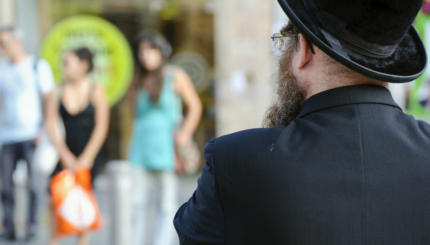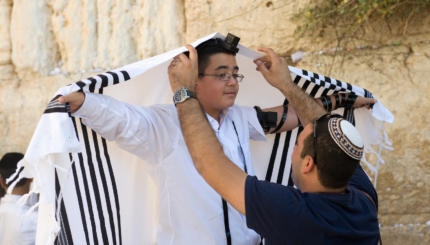Praying with uncovered head was the rule for many years in American Reform synagogues. This rule, at odds with traditional Jewish custom, was evidently based on the prevailing standards of honor and respect in the general culture which dictated that one remove one’s hat when inside a building and during solemn occasions such as worship.
In 1928, Rabbi Jacob Z. Lauterbach, a professor at the Hebrew Union College and chair of the CCAR Responsa Committee, wrote a richly-detailed study in defense of the Reform practice, declaring that “there is no law in the Bible or prescribing the covering of the head for men when entering a sanctuary, when participating in the religious service, or when performing any religious ceremony.”
Where the Customs Arose
The practice of covering the head is not based on any explicit statement in Jewish legal sources; it “is merely a custom, a minhag, that first appeared among the Jews in Babylon” during the rabbinic period (roughly, from the beginning of the Common Era to 500 C.E.). In Palestine, by contrast, the sources indicate that “people would not hesitate entering a synagogue, reading from the , and participating in the religious service with uncovered head.”
This difference in custom made its way to medieval Europe: in Spain, which tended to follow the Babylonian practices, authorities required that the head be covered during prayer, while in France and Germany, which were more influenced by Palestinian ritual traditions, there is some evidence that Jews would pray bareheaded.

Help us keep Jewish knowledge accessible to millions of people around the world.
Your donation to My Jewish Learning fuels endless journeys of Jewish discovery. With your help, My Jewish Learning can continue to provide nonstop opportunities for learning, connection and growth.
Although by the thirteenth century the Northern Europeans (Ashkenazim) had begun to adopt the Spanish (Sephardic) custom, later authorities in central and eastern Europe continued to write that the prohibition against worshipping bareheaded “has no foundation in the Talmud.” As one of them remarked (in Lauterbach’s translation): “There is no prohibition whatever against praying with uncovered head, but as a matter of propriety it would seem to be good manners to cover one’s head when standing in the presence of great men, and also during the religious service.”
What Price Custom?
From all of this, Lauterbach concluded that the custom of praying with covered head “is merely a matter of social propriety and decorum”‘ since in our own culture it is considered “good manners” to remove the hat as a sign of respect, there can be no objection to praying bareheaded. He writes: “Although in the last century the question of ‘hat on or hat off’ was the subject of heated disputes…we should know better now and be more tolerant and more liberal towards one another. We should realize that this matter is but a detail of custom and should not be made the issue between Orthodox and Reform. It is a detail that is not worth fighting about. It should not separate Jew from Jew.”
One may quibble over Lauterbach’s interpretation of a number of his sources. Some of them do not say precisely what he tells us that they say, and this tends to weaken his argument somewhat. His central point is certainly correct: Jewish law makes no absolute requirement that one cover the head to pray, to study Torah, or to participate in other religious acts. On the other hand, his conclusion — that covering the head “is merely a custom, a minhag“; “merely a matter of social propriety” — hardly reflects what is at stake in this issue, for surely he was aware that there is no such thing as “mere” custom in Judaism.
Much of Jewish ritual practice is based upon custom rather than upon Toraitic commandment or rabbinic decree, yet the tradition does not regard it as unimportant or irrelevant for that. As the old Ashkenazic saying puts it, “the custom of our ancestors is Torah.” Jews have always related to their customs with intensity and seriousness. Fierce debates in Jewish religious life are as likely to take place over matters of “mere” custom as they are over issues of Torah law and theological doctrine.
Hats and Reform Identity
This is no less true of Reform Judaism. Debates over this particular custom at times took center stage in a number of synagogues. This was because it was widely held that bareheaded worship was an essential sign of Reform identity; just as traditionalists asserted that one was not a “good Jew” if one prayed bareheaded, many liberal believed that one could not be a “good Reform Jew” and wear a hat or during prayer. Lauterbach may be right in pleading that the kippah is “not worth fighting about,” but the fact is that Reform Jews did fight about it, raucously, for many years. Many congregations went so far as to prohibit the wearing of headcovering during worship. Were the issue as marginal and unimportant as Lauterbach described it, such rules would never have been made.
Looking and Feeling Jewish
Nor does Lauterbach’s argument speak to the religious concerns of many contemporary Reform Jews, who no longer find spiritual meaning in worship conducted in accordance with a certain notion of decorum and solemnity, that is, a style that conforms to Western standards of propriety and “good manners.” This is not to say that these Reform Jews are indifferent to “good manners” or that they have turned their backs on modern culture. It is rather that they are apt to discover a more profound sort of meaning in precisely the kind of traditional worship experience which previous generations rejected. These Jews have come full circle; they want a religious service that “looks” and “feels” Jewish, one that draws deeply upon traditional forms of worship and religious life. It is no surprise that the kippah has reemerged in the Reform synagogue. Though it may not be an absolute requirement of Jewish law, it can serve those who wear it as an unmistakable sign of the tradition with which they seek to identify.
Making Informed Choices
Other Reform Jews continue to regard the kippah either as irrelevant to their religious experience or reject it as a reminder of a style of observance that the movement has long since left behind. Today, therefore, many choose to wear a kippah during worship and study, while others do not. According to Reform doctrine, neither choice is necessarily the better one; both are legitimate exercises of the personal religious autonomy that the movement holds dear. But if the movement is officially neutral on the choice, this does not mean that the issue is trivial one, nor worthy of careful thought.
To wear or not to wear the kippah is no simple, flip-the-coin choice of “hat on or hat off.” Indeed, because it partakes deeply of the realm of symbolism, because it can serve as a concrete expression of the way in which an individual approaches Jewish prayer and Jewish life, the decision to wear a kippah or not to wear it can be the most serious kind of religious decision a Reform Jew can make. For those concerned about building strong and vital religious communities, the challenge is to create the kind of atmosphere in which individuals can make these decisions freely, without being subjected to the sort of pressure that says: “there is only one right answer for a good Reform Jew.”
Reprinted with permission from Jewish Living: A Guide to Contemporary Reform Practice.



